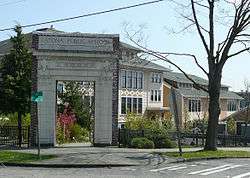John Stanford International School
John Stanford International School is an elementary school located in the Wallingford neighborhood of Seattle, Washington, United States. It serves grades K-5 in the Seattle School District and offers a dual-immersion program in Japanese and Spanish that is available to all students.[1] Formerly known as Latona School, the school is named for the late John Stanford, superintendent of the Seattle School District,[2] who died on 28 November 1998. The historic school building (1906) is a designated City of Seattle Landmark.[3]
| John Stanford International School | |
|---|---|
 | |
| Location | |
4057 5th Ave. NE Seattle, WA 98105 United States | |
| Information | |
| Type | Public |
| Established | 1891 (school) 1906 (this building) |
| Principal | Sarah Jones |
| Enrollment | 450 (approximately) |
| Campus | Suburban |
| Color(s) | |
| Mascot | Lions |
| Website | John Stanford International School |
Programs
The school is one of Seattle Public School's Bilingual Orientation Centers, serving English Language Learners who are new to the country. Students graduating from this school often move to a similar program at Hamilton International Middle School.[4]
History
The school was originally called the Lake Union School and opened in a church annex. The school opened as the Latona School in 1891. It was named for its community on the north shore of Lake Union, the community named for the Greek goddess of light. The current Landmark school was built in 1906 as one of nineteen wood frame schoolhouses based on a "model plan", of which three others were still in use in 2011 (Coe, Hay, and Stevens).[5] The building was designed by the School District's architect, James Stephen. In 1917 a three-story Renaissance style brick wing was added along the north edge of the site. In 1998 Latona Elementary School was designated as a City Landmark and following restoration in 1999, the building reopened as the John Stanford International School, Latona Campus in 2000.[6]
Facilities

The school's 1999 restoration by Bassetti Architects included the revitalization of the 1906 historic building and the educational program. The 1917 brick wing was demolished, with the approval of the City Landmarks Commission. An addition to the historic building recalls the massing, colors and details of the original and exterior paths reinforce connections to the neighborhood. Classrooms are clustered around areas for small group and project-based learning that encourage interaction between the diverse and multi-lingual student population and operable walls between classrooms allow for team teaching and larger class spaces that can be set up in non-traditional ways.
Student body
As of 2008 the school had about 400 students.[7]
Notable Alumni
- Stella Crouch, writer, musician, poet, singer and activist
Curriculum
As of 2006 each regular student spends half of his or her time studying in English, and the other half in either Spanish or Japanese. Students with English as a second language take immersion programs.[8] As of 2008, due to the popularity of its program, the school had a waitlist of about 90-100 families, with other families declining to use the waitlist due to distances from their residences.[7]
References
- School website, retrieved online 2011-04-28 Archived 2011-08-18 at the Wayback Machine
- Preservation.org case study, retrieved online 2011-04-21
- Seattle Landmarks, retrieved online 2011-04-21
- New Horizons article, retrieved online 2011-04-28
- School District history, retrieved online 2011-05-08 Archived 2010-12-31 at the Wayback Machine
- National Trust for Historic Preservation, retrieved online 2011-04-21
- "Language-immersion elementary school coming to South End" (Archive). Seattle Post-Intelligencer. Wednesday January 16, 2008. Retrieved on April 10, 2015.
- Blanchard, Jessica. "School district eyes adding more language-immersion programs" (Archive). Seattle Post-Intelligencer. Wednesday January 16, 2008. Retrieved on April 10, 2015.